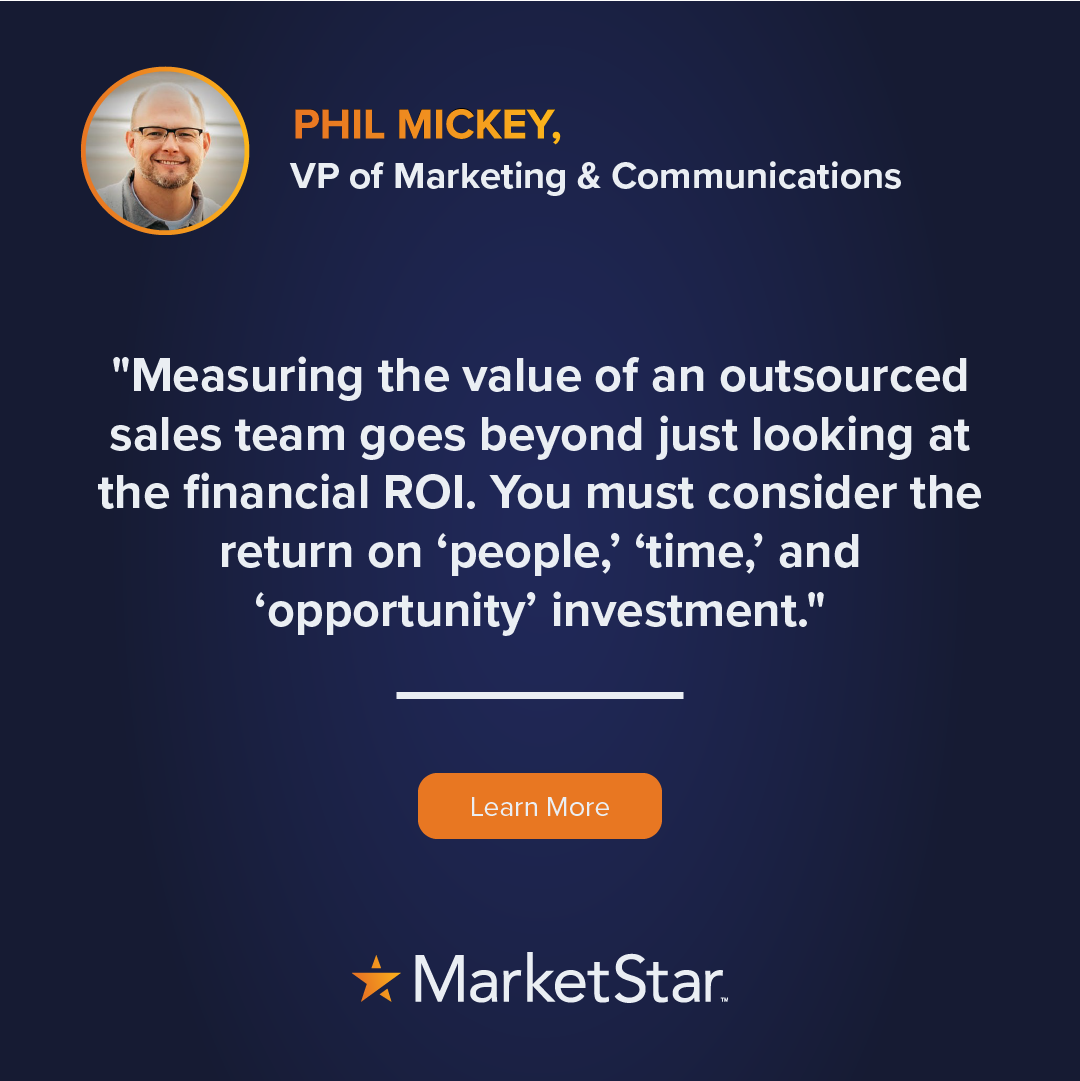See the Buy vs. Build ROI infographic summary here
Despite rapid market changes, looming economic disruption, a continual battle for talent, and increasingly complex product and service offerings, one thing never changes for sales: you must hit your number. In 2023, the mantra tied to revenue is “adapt and evolve if you want to succeed and grow.”
When it comes to overhauling and/or augmenting your sales team for agility and scale, you have two viable options: expand internally or partner up with an outsourced sales provider. This is in no way a new dilemma – outsourcing has been an option for companies for decades, but the outsourcing industry has become even more viable.
The “pandemic growth bubble”, which led to astronomical gains for some companies, has finally reached its bursting point. Layoffs, restructuring, tightening of budgets and forecasts – all of this has resulted in a very visceral and public realization of the consequences of growing your company at all costs. Revenue leaders and investors alike are now (wisely) focusing their attention on growth that is profitable, stable, and sustainable over a longer period.

A New Take on In-House vs. Outsourcing
While there are pros and cons to both having a sales team in-house or outsourcing the team, outsourcing sales can offer several distinct ROI advantages over maintaining an in-house team. However, to start, let’s look at this old argument in a new way, and instead of just listing the same old reasons (cost, flexibility, scale, speed, etc.) let’s look at everything in terms of return on investment (ROI) – and not simply based on the financial investment.
This is a 360-degree view of EVERYTHING that is being invested: time, people, and money, in addition to unaccounted capital such as innovation, experimentation, and exploration. When you look at every element of ROI, outsourcing a sizable portion of your revenue engine becomes a true force multiplier for growth in 2023 and beyond.
Return on Financial Investment
The first key of financial ROI is cost savings. Sales outsourcing is more cost-effective than maintaining an in-house sales team. According to a study by Deloitte, businesses that outsource sales operations can achieve cost savings of up to 40% compared to in-house teams. These savings are due to lower all-in costs of a single sales rep (compensation, taxes, benefits), primarily because of geography.
Most B2B companies are headquartered in major metropolitan areas such as San Francisco, New York, Seattle, Chicago, Los Angeles, and Atlanta. Although the pool of available talent in those locations may be larger, the cost of living and business operations is much higher which means higher overhead costs for every in-house rep. On the other end of the spectrum, sales outsourcing companies are often located in less expensive labor markets (for example, MarketStar has major operations in locations like Bulgaria, Ireland, and headquartered in Ogden, Utah), and have proven and effective hybrid work models. Top providers have a global network of sales professionals, enabling them to access a wide pool of talent with diverse backgrounds and skill sets. They can match the right talent to the right product, service, or market segment, resulting in more effective sales outcomes and at a measurable savings on cost of time and labor.
The second key is the profitable revenue gained through the investment. Typically, outsourced sales teams achieve anywhere from an 8:1 to 13:1 rate of return on every dollar spent. With some motions achieving even higher rates of return at a much faster pace. This is in part due to the laser focus on their craft (like sales). Outsourcers have a large pool and a deep bench of talent with the right skill sets, knowledge, and tools to sell effectively.
The best partners have worked with numerous clients, giving them insights into best practices, industry trends, and emerging opportunities. Which can help them deliver more tailored solutions, resulting in more effective and immediate sales.
According to Deloitte, 44% of businesses outsource sales functions to gain access to this specialized expertise. High ROI originates from key elements like expertise and experience, but mostly from the outsourced organizations full concentration on delivering outcomes.
This isn’t to say that there won’t be ups and downs from quarter to quarter, we see that the clients that remain with us have sustained ROI over time. The rates of return mentioned earlier are the reasons that propel the entire global sales outsourcing market to grow at an expected compound annual growth rate (CAGR) of 6.4% between now and 2028. Higher ROI is a direct indicator that an increasing number of companies are recognizing the immediate and long-term financial benefits of outsourcing their sales operations.
Return on People Investment
Cost of Hiring and Training
Hiring and training staff is historically the most expensive part of any business. The Society of Human Resource Management (SHRM) estimates that the cost-per-hire is more than $4,700, and that replacing an employee can cost between six and nine months of their salary. When you consider the cost of searching, hiring, and training sales personnel, hiring an outsourced sales team can eliminate talent acquisition headaches, growing pains, and provide a better long-term ROI. And as a bonus, you will no longer need to worry about a seat being filled. Like the old saying goes – an empty seat can’t make a sale.
Speed to Hire
Sales outsourcing providers can offer businesses a faster speed to hire, as they have established recruitment and training processes in place. This can help companies fill sales positions more quickly, resulting in a more productive sales team at a faster clip, especially with recruitment teams being some of the first to go when companies announce layoffs and hiring freezes. According to Aberdeen Group, businesses that outsource sales functions can reduce their time-to-hire by up to 25%. (At MarketStar we average a 50% faster speed to hire than in-house)
In addition to the speed to build and scale a team, outsourced teams often have lower attrition rates than in-house sales teams. Because they have established career paths and training programs – including fast movement into sales management roles, which can help keep sales professionals engaged and motivated. And while attrition can be frustrating, an outsourcer views attrition differently than a large enterprise. Attrition mitigation is built into the launch and evolution plans for each team, and just like empty seats don’t sell, they also aren’t billed back to the client. Outsourcers must move quickly to fill empty seats, for the sake of their client’s revenue goals as well as their own.
One way to do this is through what is called “active bench recruitment”, this means that while other companies hire when a spot is open, outsourcers hire even when we don’t have openings. So, when an opening inevitably happens that spot can be filled instantly with the right person rather than waiting to find the right person. The nature of outsourcing partners leaves them uniquely equipped to be better enabled to handle attrition.
Market Expansion
When things are going very well, and it’s time to expand into new market segments, new geographies, or broaden your current book of enterprise business, outsourcing providers can offer companies greater flexibility in scaling people up or down based on market conditions or revenue goals. According to a survey by McKinsey, 48% of businesses outsource sales functions to increase their geographic reach. Outsourcers have the infrastructure and resources to adjust to expand quicker, which can help companies achieve their sales targets more effectively. Outsourcers are essentially a “people cloud” which allows you to dial your selling output up or down depending on the situation.
Return on Time Investment
Infrastructure and Processes
Building a fully-functional, enterprise-level sales infrastructure and enablement program can take up to 12 months to implement. During these 12 months' time is spent on strategy and planning, technology implementation, training and enablement, and change management.
After implementation you will need to assess your company's existing sales processes, identify gaps, and develop a plan to address these gaps. The process can take several months to complete, particularly for larger organizations. Outsourcers have processes dialed in at day one, even with the inevitable tweaks required to customize it to your customer lifecycle or product mix.
Technology
Technology implementation, building and launching the right sales tech stack is critical. This process can be time-consuming, particularly if the company is transitioning from legacy systems or adopting new technologies for the first time. According to Salesforce, implementing a customer relationship management (CRM) system can take anywhere from 3-12 months, depending on the complexity of the organization.
If you do get your systems in place quickly, training and development is a critical component of putting them to work for you. This involves developing a training curriculum, selecting trainers, and delivering training sessions to the sales team costing you precious time. Not to mention the time it takes if you are moving from existing workflows to proven sales processes and the change management that is necessary for your organization’s growth.
Sales outsourcing providers are trained and have access to the latest sales technologies and tools, including CRM software, sales analytics, sales acceleration, AI-based tools, and sales automation platforms. They leverage these tools to improve sales performance, drive productivity, and streamline sales processes.
According to a survey by Salesloft, 70% of sales leaders believe that their company's sales technology stack is either "inefficient" or "needs improvement." The same report also reports businesses that leverage sales technology effectively can achieve up to a 300% increase in ROI.
The top outsourced sales partners offer “out of the box” solutions that cover all the elements mentioned above in one master services agreement (MSA). For MarketStar, most outsourced teams can be launched and active within 6-8 weeks, roughly 50% faster than typical in-house teams, the real time ROI comes from a faster ramp to revenue. Outsourced teams consistently drive revenue within four to six months, rather than up to a year by a newly established in-house team. Time is money, and with most large companies being controlled by shareholders and management boards, return on the investment of time is a pivotal KPI sales outsourcers can close the gap on.









